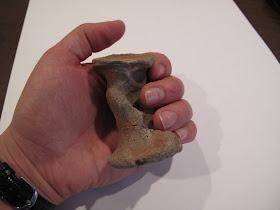 |
| Squatty separator. Pawley Kiln site, Baltimore, MD. Courtesy, Maryland Archaeology and Conservation Lab. |
I am getting ready for a presentation on my kiln furniture research this weekend in Virginia. In doing so, I have been thinking a lot about how to visualize how the furniture was made. It helps having access to clay! One of the most fascinating pieces of kiln furniture is a separator, often called many things, but in following the most commonly used term, and Georgeanna Greer's terminology, we're going to call the shape a spool.
 |
| My hand around a separator, showing my fingers over the hand print on the separator. Webster kiln site, Fayetteville, NC. Courtesy, The Museum of the Cape Fear |
This piece of kiln furniture was likely made as the kiln was being loaded as the sizes and lengths often vary, and the nature of its use would make it necessary to be made while loading. As seen in the image below, the spool separators were likely used in the context of stacking jugs (seen in yellow and red below) and were also used to separate straight-sided vessels which were stacked on top of one another.
 |
| Conjectural drawing of kiln furniture in use. Drawing by Mike Heindl. |
I made a few photos of how I am pretty sure this piece of kiln furniture was made. First, a bit of clay was rolled out. This rolling is evidenced by broken examples which show the spiraled pattern of the clay on the interior.
 |
| Rolling out the clay |
 |
| Rolling |
 |
| Rolled clay |
Then the rolled section was grasped in the palm of the hand. A fascinating aspect of this project has been to see the various finger and hand prints left behind by the workers making the kiln furniture. Some of the fingerprints have been very tiny, like children's, and some of them are very, very large.
 |
| Grasping the rolled clay |
Then the ends were smashed flat. These flattened areas would then fit to the edge or side of whatever vessel this piece was applied to.
 |
| Flattening one side |
 |
| Flattened end |
 |
| Flattening the other side |
Ta-da! Quickly made kiln furniture, with the same impressions as found on the archaeological materials.
 |
| Kiln furniture, ready for use! |
If you are in the Alexandria, Virginia area, be sure to come by the
Alexandria Archaeology Museum this Saturday, January 28th, at 10:00 for my presentation. Should be informal, and hopefully informative!












super cool brenday!! love this kinda techy nerdy stuff myself! i have also heard them referred to as dog bones.
ReplyDeleteshane
Just like watching History Detectives. Like Shane, I love this stuff too.Alexandria is about 400 miles too far away for me to make it but I would love to see your presentation some time. Have fun.
ReplyDeleteFascintating! Wish I could hear the presentation- thanks for sharing some of the highlights...
ReplyDeleteJust wait until I get my wood kiln built, then I am going to put these pieces into practice! Shane, there are innumerable terms applied to these guys. I have chosen to place them in the category of "separator" and term them "spools." I should make a list of all of the crazy terms I have seen applied to kiln furniture. I recently came across a piece referred to as a "taco"!
ReplyDeleteIt's all about the mater of wow! Great demonstration regarding kiln furniture and I found it very interesting to see as well. Anyway, thanks for sharing this.
ReplyDeleteJessica@ white furniture
Thanks for your note, I'm glad you enjoyed the little demonstration - it's important to think about ALL aspects of historic pottery, including the esoteric!
ReplyDeletecool article, I find peaces like this all over by the Walloomsac river, some even have the finger prints of the maker most are from the Norton pottery in Bennington VT. What are some of the names of other types of kiln furniture? I have also found long flat peaces of clay one one that look like back bones.
ReplyDeleteI would love to see photos of the pieces from VT, I have not seen any kiln furniture from up there, mostly because it is my understanding that the kilns excavated are post 1850 (the parameters of my study stopped at 1850) and largely industrial. I'm currently wrapping up an article to hopefully get published next year in the American Ceramic Circle Journal which will talk about other kinds of kiln furniture. Some of the other forms include spools and crescents (what I was calling a separator here), bars, saggars, jug stackers, and draw trials.
ReplyDelete